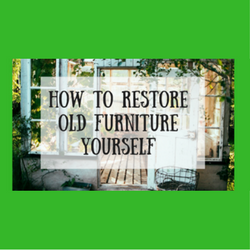So, you have a priceless heirloom from your dear old relatives which were given with love but without regular upkeep. Perhaps it’s an old chair, or table, or even a grandfather clock or rug. While it would be easy to throw them out, it’s likely you wouldn’t be able to shake the feeling you are getting rid of something special, and in that way getting rid of a loved one’s connection to your life.
 There is an alternative: you could restore old furniture yourself, and make the old gifts (or inheritances) of family members just as useful as they were when first purchased however many years ago.
There is an alternative: you could restore old furniture yourself, and make the old gifts (or inheritances) of family members just as useful as they were when first purchased however many years ago.
You’ll soon love this little project and even develop a taste for it. A taste that can actually become lucrative. Future craftsmen like you, are in good hands.
Restoring Old Wood Furniture
Often, a piece of good old wood is hiding under a layer of varnish, or paint, or just years of dirt and grime. Even if a piece of furniture doesn’t look too well kept upon first glance, it can be salvageable if the wood itself is in good shape. In fact, sometimes you can get a better value at a sale or auction with big pieces of good wood that are completely covered by ugly varnish. Other people won’t be able to see the prized materials underneath. Look for pieces that aren’t chipped or cracked.
If you’re going to restore old furniture, make sure you are in a well-ventilated place. Because you will likely be using a paint-stripper, please follow all of the safety instructions on the label. According to BobVila.com, “Before you work with a furniture stripper, be sure you read and follow the manufacturer’s directions. They will include safety precautions, application instructions, wait time and clean-up—all important considerations when working with a chemical solvent. Also, be sure to remove hardware or cover exposed metal with painter’s tape to avoid damage from the stripper.”
Things You Will Need
Remember that any kind of paint stripper is a very serious chemical, and should be used with care. You will need:
- goggles
- long sleeved clothes
- gloves
- paint stripper
- rags
- metal scraper
- Grade 000 Steel Wool
- Stain (optional)
- Paintbrushes (optional)
- And protective boots like:
Step One
Before you start stripping off all the paint, make sure that the old wood furniture is as clean as possible. Then, according to Phil Hey, you ought to “flow on semi-paste stripper, heavily but gently, with a rag swab. Wait an hour . . . and when the chemical has raised the paint, push off the coating…” Try to follow the instructions as they are listed on your particular stripper. Some may take more time and some may take less.
After you have pushed off most of the stripped paint, go at the furniture gently with the metal scraper if there are still some bits stuck to the wood. Remember to be as gentle as possible so as not to scratch the wood grain. Then, you can use the steel wool to get any remaining paint off of the table. Let the wood dry, and then go at it again with some more steel wool (hopefully a clean portion). At this point, you’re not trying to sand down the wood, but rather just give a finishing touch, making sure that the paint has been taken completely off. You should be sanding with the grain of the wood, not against it. Finally, dust off with a rag.
Step Two
Some people think that natural wood is fine on its own, and shouldn’t be messed with any more than necessary. Others want to add a certain amount of stain, to help with the resale value or perhaps to make it match other pieces of furniture already in your home. It might be the case that the color of the wood is uneven, in which case staining it may be a good idea to equalize the tone. If you do decide to add a stain, make sure to apply it in the direction of the grain, in light, even coats. Try to make it look as natural as possible, and rub it down with a rag after it has dried.
Step Three
Important: if you are going to stain the furniture, you must do it before you add the varnish. Let the stain dry for at least 24 hours before adding the varnish with a rag. Apply the varnish slowly and evenly with a rag, and let it dry completely before adding another coat. Use light coats until you get the surface sheen that you prefer. The varnish will protect the wood and make it water proof. Once dry, some people recommend sanding it lightly to temper the sheen to your desired level. Ultimately, it’s up to you. Once the varnish has completely dried and it’s at the level of glossiness which you prefer, you can add some paste wax in order to give the wood a luxurious, deep, richness. The wax should be added after the varnish.
Your Priceless Family Heirloom Is Saved
And there you have it, the old furniture that you thought would be lost forever can have an entirely new life, a life where the beautiful original wood can return to warm itself in the daylight, and your connection to the people who used that old wood can shine on its own in your heart.
Author bio:
Amanda Wilks is a regular guest blogger and an avid DIY-er constantly looking for a new project to tackle. It’s always advised to use protective gear when operating with wood and power tools. See what else Amanda is building here @AmandaWilks01.
- DIY Chicken Wire Jewelry Holder - June 27, 2022
- Jewelry Designer Manager Alternative - December 8, 2019
- 3 Tips To Immediately Boost Your Sales Today - May 12, 2019

